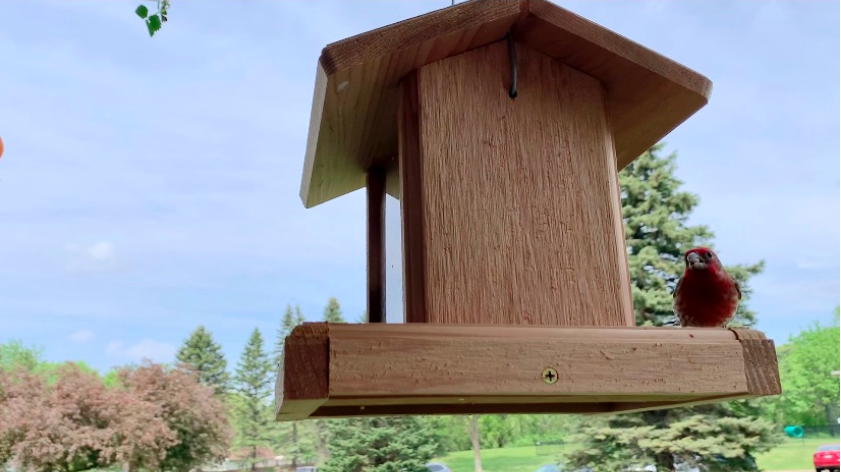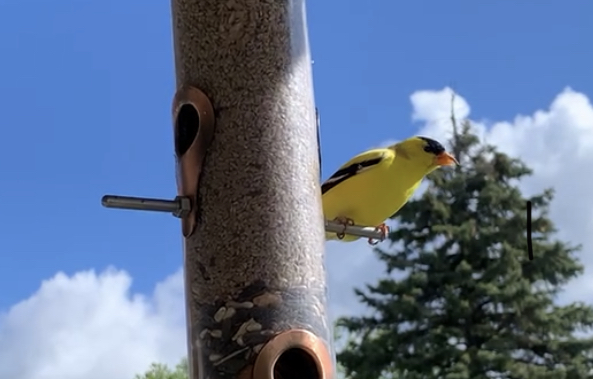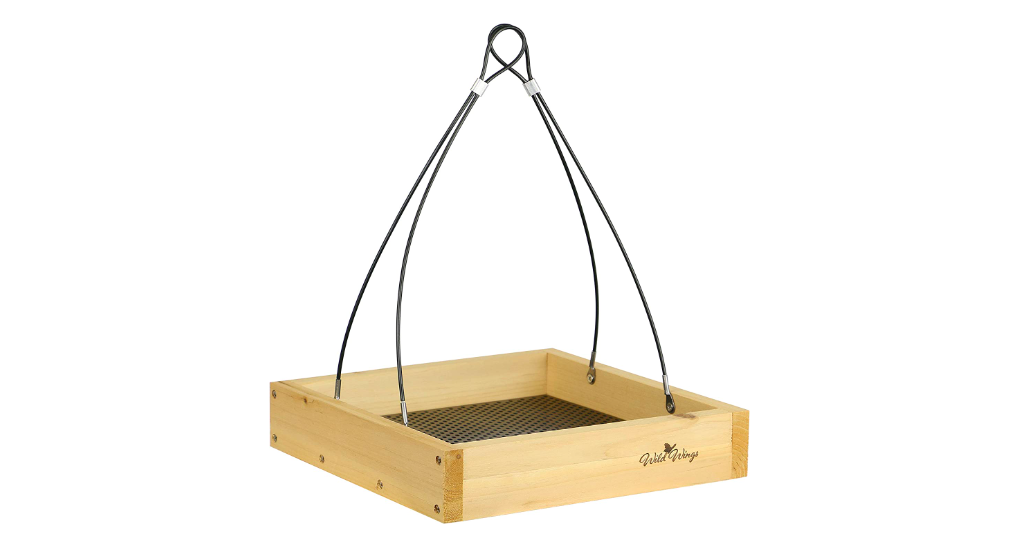You’ll encounter a variety of designs when shopping for bird feeders. Trays, tubes, hopper and platform feeders, to name a few. It can be overwhelming to select the right one with so many options available. My head spins when I see the dozens of feeders on sale at Menards
I created this guide to simplify the process and help you choose your next bird feeder. I’ll list the various types of bird feeders available and the birds they attract in this post. I’ll also include links to shop on Amazon. But, most bird retail stores and hardware stores carry these feeders as well.
Hopper Bird Feeders

Hopper feeders are one of the most popular bird feeder types and a personal favorite of mine. They have a house design with a large, open tray for birds.
Hopper feeders are great for attracting a variety of bird species, including Chickadees, Finches, Blue Jays, and Cardinals. They’re easy to fill and hold a significant amount of bird seed, making them an excellent choice if you don’t want to constantly refill your feeders.
Birds this feeder will attract: Just about everything! Hopper feeders have space and support to accommodate any bird. I often recommend this feeder design for newcomers to the hobby.
Downsides: They aren’t squirrel and rodent proof. The open space of a hopper feeder allows birds to make a larger mess below the feeder.
Link to browse hopper feeders on Amazon
Tube Bird Feeders

Tube feeders are long, narrow bird feeders with holes and several perches for feeding. So, they’re great for attracting small bird species, such as finches and sparrows, that prefer to cling on a small perch while eating. Less of a mess usually comes with tube feeders because birds have to reach into the ports to grab seed.
Birds this feeder will attract: Finches! House Finches and Goldfinches are fans of this design. I love the sight of Goldfinches at my tube feeder in the spring. In my experience, Cardinals will also use tube feeders if you get one with long enough perches for them.
Downsides: Most tube feeders don’t have enough space for bigger birds like Blue Jays to use. Some cheaper tube feeders are made with lower quality materials and can break down.
Link to browse tube feeders on Amazon
Suet Feeders

Suet feeders are designed to hold blocks (or other shapes) of suet, a high-energy food made from animal fat. They are typically made of wire mesh or plastic and can attract woodpeckers, nuthatches, and chickadees.
There are regular-sized suet cages and larger versions with tail props to support larger birds like Pileated Woodpeckers. There are also suet logs, which imitate tree branches and have holes for suet plugs.
Birds this feeder will attract: Woodpeckers, Nuthatches, Chickadees
Downsides: Not many! Suet can sometimes be messy, but it’s an easy price to pay for Woodpeckers.
Link to browse suet feeders on Amazon
Platform Feeders

Platform feeders are flat, open trays that can hang or be placed on the ground. They’re great for attracting ground-feeding bird species, like Mourning Doves and Juncos.
If you hang a platform feeder (like the one pictured above), it’s similar to a hopper feeder in that it will hold a lot of bird seed and offer support to birds of all sizes. Accordingly, it’s an essential crowd-pleasing feeder if you’re looking to start a big feeding station in your yard.
Birds this feeder will attract: Nearly anything in the air! On the ground: Juncos, Doves, Cardinals, Sparrows.
Downsides: Tray feeders are easy for squirrels and other rodents to get into if they’re in jumping distance or on the ground.
Link to Browse Platform Feeders on Amazon
Hummingbird Feeders

Hummingbird feeders are designed to hold nectar. They are usually made of plastic or glass and have small colorful feeding ports that allow access to the nectar. Some hummingbird feeders are relatively small and straightforward. There are also more decorative glass hummingbird feeders that can make your yard pop.
Birds this feeder will attract: Hummingbirds (of course), but you might also get Orioles and Red-Bellied Woodpeckers stopping by for a sip of nectar on occasion
Downsides: Nectar also draws in ants and bees. Investing in a feeder that has an ant guard is well-worth it. You need to clean hummingbird feeders often to prevent mold.
Link to browse hummingbird feeders on Amazon
Related Content: How to Make Hummingbird Food
Thistle Feeders

Thistle feeders, also known as nyjer feeders, are designed to hold tiny, thistle seeds. They are typically made of mesh and aim to attract small bird species, such as goldfinches and siskins.
You can buy a tube-style thistle feeder like the one pictured above. There are also thistle seed sock feeders that Goldfinches can cling to. I’ve used these on my patio in the past with a lot of success, especially in the spring!
Birds this feeder will attract: House Finches, Gold Finches, Chickadees
Downsides: Won’t attract or support larger birds like Cardinals and Blue Jays
Link to browse thistle feeders on Amazon
Oriole Feeders

Oriole feeders are specifically designed to hold orange slices, grape jelly, and sometimes nectar – favorite foods for migrating Orioles. They should also have the color orange, which Orioles are attracted to.
I have my feeder out by the end of every April and have always had luck with several Orioles dropping by. It’s a sight I’ll never forget! My regular House Finch visitors also love having grape jelly in the summer on my Oriole feeder.
Birds this feeder will attract: Orioles, House Finches, Tanagers and Grosbeaks
Downsides: Usually won’t attract or support larger birds like Blue Jays
Link to browse Oriole bird feeders on Amazon
Related Content: Everything You Need to Attract Baltimore Orioles
Bonus: Squirrel-Proof Bird Feeders

This is a category I wanted to add in. Squirrel-proof bird feeders come in a ton of different shapes and sizes, but I recommend them to anyone in this hobby looking to stop or slow squirrels from eating up their bird food.
These feeders have a weight-sensitive design, allowing birds to perch on them, but closing if something heavier (like a squirrel) tries to get in.
You can find squirrel-proof feeders at any store that sells bird supplies, or on Amazon. The feeder I use and love is the legacy squirrel-buster feeder.
Disclaimer: Links found on this page are Amazon affiliate links. If you click an affiliate link and make a purchase, I might earn a commission. As an Amazon Associate I earn from qualifying purchases. (There’s no extra cost to you if you do this).

Pingback:6 Reasons Why Birds Aren’t Coming to Your Feeder and How to Fix Them - BIRD BITES